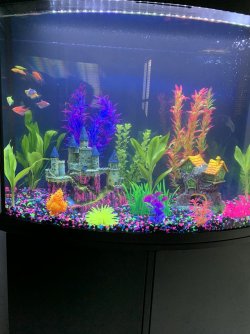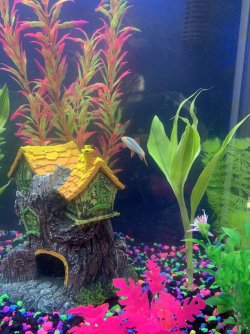I'd like to mention what I feel is the most important factor in stocking the tank, when considering a number of things including but not limited to whether it is overstocked or not. And that is, the requirements of the fish species. And before getting to this, I'd like to make it clear that I am not criticizing
@carligraceee nor anyone else. The initial question mentioned certain numbers of certain fish species, and that is what I am concerned with here.
One reason the 10g tank is overstocked, or to perhaps be more accurate,
inappropriately stocked, is because of the needs of the species. I will only deal with neon tetras,
Paracheirodon innesi, here. This species needs a much larger tank space--if we want it to thrive rather than just survive. The distinction between these two terms is frequently blurred if it is even recognized. But reliable sites recommend at minimum a 24-inch/60cm long tank, which could be a standard 15g or 20g tank. There is now scientific evidence for this; this species is a shoaling/schooling species, which means not that it swims around together (it may or may not) but that it absolutely needs a number of its own, and that is where the tank space comes into the equation.
Earlier this week I posted data from an article on the effect of the number of individual fish within a shoaling species, and
P. innesi just happens to be one of the four species used in this study. The study investigated the welfare of the fish in relation to group size. Factors studies included aggressiveness (which increased in the smaller group), darting (fright), shoaling, and latency to feed. In summary, there was incontrovertible evidence in that study that this species will be significantly healthier and less prone to detrimental issues in a group of 10 than it will in a group of five. The conclusion is clear: the more fish in the group, the better their condition, health and well-being will be, so instead of attempting to have six neons in a 10g, select another species that will be better suited, or provide a larger tank so that the expe3ctations of the fish can be met. The reward is healthier fish and more successful keeping of the fish. And that is why the 10g is "overstocked," or inappropriately stocked, because if we provide adequate numbers the space is detrimental.
Those who may not have seen the earlier post on the study may wish to read it, here:
The number of fish needed for species "x" to be healthy and less stressed in an aquarium is a topic that enters quite a number of threads on TFF. Some of us realize how vitally important the number of fish for a particular species really is, but having scientifically-controlled studies that...

www.fishforums.net







 ?
?